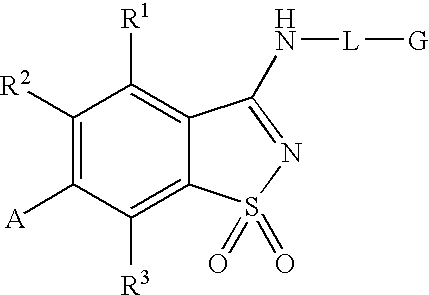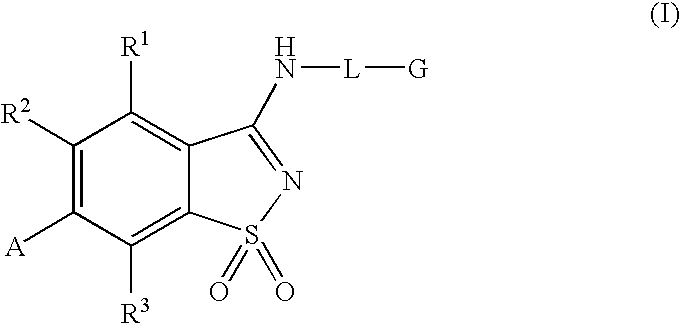Antagonists to the vanilloid receptor subtype 1 (VR1) and uses thereof
a vanilloid receptor and antagonist technology, applied in the field of anti-vanilloid receptor sub-type 1 (vr1), can solve the problems of cell membrane depolarization, and achieve the effects of urinary dysfunction, pain treatment, and inflammatory hyperalgesia
- Summary
- Abstract
- Description
- Claims
- Application Information
AI Technical Summary
Benefits of technology
Problems solved by technology
Method used
Image
Examples
example 1
N-(4-tert-butylphenyl)-6-(3-chloropyridin-2-yl)-1,2-benzisothiazol-3-amine 1,1-dioxide
example 1a
3-chloro-2-(4-methylphenyl)pyridine
[0069] A solution of 2,3-dichloropyridine (0.9663 g, 6.5 mmol),p-tolylboronic acid (0.8569 g, 6.3 mmol) and tetrakis(triphenylphosphine)palladium(0) (0.3618 g, 0.31 mmol) in 0.5 M Na2CO3 (25 mL) and acetonitrile (25 mL) was flushed with N2, sealed and heated at 85° C. for 16 hours. The reaction mixture was cooled to room temperature and the volume reduced by half under vacuum. The concentrate was extracted with dichloromethane (3×20 mL), dried (MgSO4) and condensed to yellow-green oil. The residue was purified by column chromatography, eluted with hexanes:ethyl acetate:dichloromethane (7:2:1)) to provide the title compound as a yellow-orange oil. MS (ESI+) m / z 203 (M+H)+; 1H NMR (DMSO-d6) δ 2.38 (s, 3H), 7.30 (d, J 8.2, 2H), 7.42 (d, J 8.2, 1H), 7.59 (d, J 8.2, 2H), 8.03 (d, J 8.1, 1H), 8.62 (d, J 6.1, 1H); Anal. Calc'd for C12H10ClN.0.1H2O: C, 70.15; H, 5.00; N, 6.82. Found: C, 70.06; H, 4.67; N, 6.67.
example 1b
6-(3-chloropyridin-2-yl)-1,2-benzisothiazol-3-ol 1,1-dioxide
[0070] Chlorosulfonic acid (3.0 mL, 45.1 mmol) was added dropwise over 20 minutes to the product of Example 1A (2.3 g, 11.3 mmol) at about 0° C. The reaction mixture was then heated at 115° C. for 1 hour. The reaction mixture was cooled to 0° C., and treated with ice / ice water. The resulting black oily residue was extracted with dichloromethane (2×30 mL) and the isolated organic extracts were concentrated. The residue was taken into 30 mL of ether: aqueous NH4OH (1:1) and stirred until gas evolution stopped, diluted with H2O (40 mL) and extracted with ethyl acetate (3×50 mL). The combined organic fractions were washed with brine (1×50 mL), dried (MgSO4), filtered and condensed to a white solid, 2.08 g. This white solid was suspended in 1 M NaOH (25 mL) and heated to 80° C. Potassium permanganate (3.55 g, 22.5 mmol) was added in small portions over 40 minutes. The reaction mixture was stirred for another 20 minutes before q...
PUM
 Login to View More
Login to View More Abstract
Description
Claims
Application Information
 Login to View More
Login to View More - R&D
- Intellectual Property
- Life Sciences
- Materials
- Tech Scout
- Unparalleled Data Quality
- Higher Quality Content
- 60% Fewer Hallucinations
Browse by: Latest US Patents, China's latest patents, Technical Efficacy Thesaurus, Application Domain, Technology Topic, Popular Technical Reports.
© 2025 PatSnap. All rights reserved.Legal|Privacy policy|Modern Slavery Act Transparency Statement|Sitemap|About US| Contact US: help@patsnap.com



